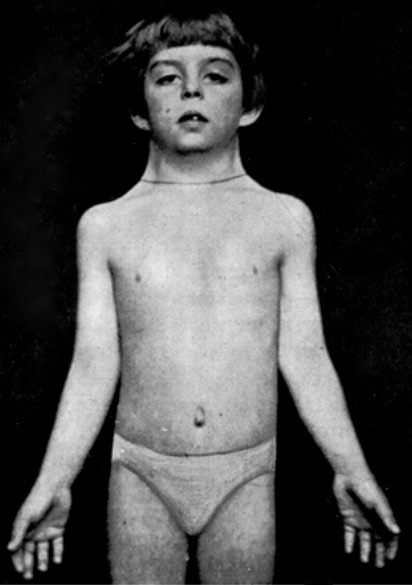Otto Ullrich
Otto Ullrich (1894 – 1957) was a German pediatrician.
One of the founders of clinical genetics in Germany making contributions to syndromic delineation and dysmorphology
Eponymously remembered for his description of Ullrich-Turner syndrome (1930)
Biography
- Born 7 January 1894
- 1939-1943 Professor of paediatrics, Universität Rostock
- 1943-1957 Professor of Pediatrics, University of Bonn
- 1952 – Elected to the Deutsche Akademie der Naturforscher Leopoldina
- Died 22 October 1957 in Bonn, Germany
Medical Eponyms
Ullrich-Turner syndrome (1930, 1938)
1930 – Otto Ullrich presented, in the former Zeitschrift fur Kinderheilkunde (present European Journal of Pediatrics) the case of an 8-year-old girl with the complete clinical picture of this disorder including congenital lymphedematous redundancy of the skin of the nape of the neck together with congenital lymphedema of hands and feet with nail ‘dysplasia,’ sphinx-like expressionless face with cranial nerve palsies including bilateral ptosis and facial nerve weakness with so-called fish like mouth and high and narrowly arched palate, low-set ears and low posterior hairline, later development of pterygium colli; hypoplastic nipples and cubiti valgi; and shortness of stature and normal intellectual development.
Ullrich congenital muscular dystrophy (1930)
Ullrich congenital muscular dystrophy is characterized by generalized muscle weakness and striking hypermobility of distal joints in conjunction with variable contractures of more proximal joints and normal intelligence. [Ullrich’s congenital, atonic-sclerotic muscle dystrophy; UCMD]
Bonnevie-Ullrich syndrome (1932, 1934. 1936)
Congenital syndrome consisting of short stature, syndactyly, webbed of the neck (pterygium colli), peripheral lymphoedema of the hands and feet, hypoplasia of bones and muscles, laxity of the skin, dystrophic nails, and motor disturbances of the cranial nerves. Aetiology unknown. Inheritance either X-linked or autosomal dominant.
In what proved to be a trail-blazing discovery in the field of mammalian phenogenetics, Kristine Bonnevie (1932, 1934) was enabled by a discerning combination of genetic experiments and embryological analysis to reach a flawless clarification of the formative events underlying various multiple anomalies in an abnormal strain of the house mouse. The mutation analyzed by her was one recovered by Bagg and Little (1924) from a race of inbred, x-rayed mice. It proved to be a monogenic recessive abnormality manifesting itself in the form of very diverse malformations of the head and extremities.
This astonishing revelation of the formative processes responsible for multiple anomalies in Bagg-Little (my) mice was utilized by me in 1936 for the elucidation of very similar complexes of deformities in man.
Ullrich 1949
Later the term “Bonnevie-Ullrich” was applied to any form of nuchal webbing which followed localised lymphoedema. This designation included females with gonadal dysgenesis (X0) and males with stunted stature, neck webbing and structural cardiac defects (Noonan syndrome).
1965 – Ferguson-Smith defined gonadal dysgenesis in terms of karyotype-phenotype correlations. The eponym “Bonnevie-Ullrich” was applied to the “male Turner” syndrome.
1968 – Noonan further defined the “male Turner” syndrome and her name then replaced the eponym of Bonnevie-Ullrich.
Currently, the term Turner syndrome is applied to females with gonadal dysgenesis and an XO chromosomal constitution; Noonan syndrome for males with stunted stature, variable neck webbing, structural cardiac defects and normal chromosomes; and the Bonnevie-Ullrich eponym has largely fallen into disuse.
Major Publications
- Ullrich O. Kongenitale, atonisch-sklerotische Muskeldystrophie, ein weiterer Typus der heredodegenerativen Erkrankungen des neuromuskulären Systems. Zeitschrift für die gesamte Neurologie und Psychiatrie 1930; 126: 171–201
- Ullrich O. Über typische Kombinationsbilder multipler Abartungen. Zeitschrift für Kinderheilkunde 1930; 49(3): 271-276 [Ullrich-Turner syndrome]
- Ullrich O. Congenital, atonisch-sklerotische Muskeldystrophie. Monatsschrift Kinderheilkunde, 1930; 47: 502-510. [Ullrich syndrome]
- Ullrich O. Angeborene Muskeldefekte und angeborene Beweglichkeitsstörungen im Gehirnnervenbereich. Handbuch der Neurologie, 1936; 16: 139
- Ullrich O. Zur Phanogenese kombinierter Missbildungen. Monatsschrift Kinderheilkunde, 1937; 63: 94-100.
- Ullrich O. Neue Einblicke in die Entwicklungsmechanik Multipler Abartungen und Fehlbildungen. Klinische Wochenschrift 1938; 17: 185–190
- Ullrich O. Die Pfaundler-Hurlersche Krankheit: Ein Beitrag zum Problem pleiotroper Genwirkung in der Erbpathologie des Menschen. Ergebnisse der Inneren Medizin und Kinderheilkunde 1943; 63: 929-1000. [Scheie’s syndrome]
- Ullrich O. Uber polyphane und pleiotrope Genwirkung in der Erbpathologie des Menschen: Erlautert an Beispielen von multiplen Abartungen (Status Bonnevie-Ullrich und Pfaundler-Hurlersche Krankheit). Zeitschrift für menschliche Vererbungs- und Konstitutionslehre. 1944; 27: 651-681.
- Ullrich O. Turner’s syndrome and status Bonnevie-Ullrich. Am J Hum Genet 1949; 1: 179–202
- Ullrich O. Turner’s syndrome and status bonnevie-ullrich; A synthesis of animal phenogenetics and clinical observations on a typical complex of developmental anomalies. Am J Hum Genet. 1949;1(2):179-202. [Morgagni-Turner-Albright syndrome]
- Ullrich O. Der Status Bonnevie-Ullrich im Rahmen anderer “Dyscranio-Dysphalangien.” Ergebnisse der inneren Medizin und Kinderheilkunde, 1951; 2: 412-466. [Bartholin-Patau syndrome]
- Ullrich O, Fremerey-Dohna H. Dyskephalie mit Cataracta congenita und Hypotrichose als typischer Merkmalskomplex. Ophtalmologica, 1953; 125(3): 73-90; 144-154. [Hallermann-Streiff-François syndrome]
- Ullrich O, Weicker H. Morphologische und statistische Untersuchungen über die intrauterine Absterbeordnung in der ersten Hälfte der Schwangerschaft. Klinische Wochenschrift 1957; 35: 687–688
References
- Cotterman CW. Status Bonnevie-Ullrich. Genetics. 1948; 33(6): 607.
- Wiskott A. Otto Ullrich zum Gedächtnis. Zeitschrift für Kinderheilkunde 1958; 81: 1–4
- Ferguson-Smith MA. Karyotype-phenotype correlations in gonadal dysgenesis and their bearing on the pathogenesis of malformations. J Med Genet. 1965;2(2):142-155.
- Wiedemann HR. The pioneers of pediatric medicine: Otto Ullrich (1894-1957). Eur J Pediatr. 1986; 145(6): 453.
- Opitz JM. Otto Ullrich: an appreciation. Am J Med Genet. 1991;41(1): 126‐127.
- Wiedemann HR. Otto Ullrich and his syndromes. Am J Med Genet. 1991; 41(1): 128‐133
- Carey JC. The Otto Ullrich award for excellence in clinical genetics. Am J Med Genet. 1991; 41(1): 125
- Wiedemann HR, Glatz CJ. Follow-up of Ullrich’s original patient with “Ullrich-Turner” syndrome. Am J Med Genet 1991; 41:134-136.
- Beighton P, Beighton G. The Person Behind the Syndrome. Springer 2012: 168
- Professor für Kinderheilkunde. Otto Ullrich. Catalogus Professorum Rostochiensium, Universität Rostock



